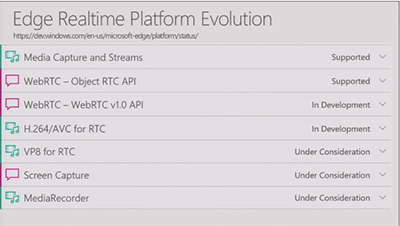News
Microsoft Previews Skype Calls Using Edge Without Plug-Ins
Microsoft is previewing Skype voice and video communications using its Edge browser without the use of browser plug-ins.
It's possible to test these capabilities today under certain conditions. For instance, it'll work for one-to-one calling and for group calls if communications take place between Edge browsers. It'll also work between an Edge browser and some Skype clients, such as Skype for Windows and Skype for Mac, but just for one-to-one calls, per Microsoft's announcement.
If a call participant lacks the latest Skype client, they "may be prompted to install a plug-in," Microsoft explained. It's just supported on Edge using Windows 10 versions 10.0.10586 and higher.
Microsoft has multiple Skype clients that will support voice and video calling without plug-ins, including "Skype for Web, Outlook.com, Office Online and OneDrive," while using the Edge browser.
The aim of Microsoft's effort is not just to support voice and video in Edge without plug-ins, but for this capability to work across all browser makes as well. Here's how Microsoft's announcement characterized the effort:
Today's launch is exciting news and is the first step towards fulfilling the commitment we've made to support WebRTC in Skype and Skype for Business. But we want to bring seamless calling to everyone, not just people using Microsoft Edge. To make this a reality, we will continue to work on enabling audio and video interoperability with Chrome and Firefox browsers, once they both support the H.264 video codec.
WebRTC is a specification that emerged from work at the World Wide Web Consortium (W3C). It started with the Object Real Time Communication (ORTC) specification for sending and receiving real-time media, which was originally proposed by Hookflash. Microsoft, Google and Hookflash later collaborated on that spec, producing ORTC APIs, which are the basis for the WebRTC 1.0 spec.
Some of the objects in the WebRTC spec are currently used in Google's Chrome and Mozilla's Firefox browsers. The Edge browser currently supports Web RTC 1.0 APIs.
This history was outlined by Bernard Aboba, a principal architect at Microsoft, during a session at Microsoft's recent Edge Web Summit event. He explained that it has been a challenge to support Real Time Communications (RTC) applications that will work across the various Windows 10 devices. There are issues concerning bandwidth adaptation, as well as resolution and frame-rate support. In addition, mobile device use of voice and video present problems such as burst loss. Glitches can happen when mobile devices are moved between networks, he said.
Aboba showed the following slide, which outlines Edge browser RTC support plans:
 [Click on image for larger view.]
Microsoft's Real Time Communications support plans for its Edge browser. Source: Microsoft Edge Web Summit session.
[Click on image for larger view.]
Microsoft's Real Time Communications support plans for its Edge browser. Source: Microsoft Edge Web Summit session.
Microsoft is backing cross-browser support for the H.264/AVC video codec with "the eventual goal of an interoperable RTC experience," the Edge team explained in a blog post. Support for H.246/AVC is showing up in Firefox, as well as in a test version of Chrome, the team noted. This video codec support will get previewed in a future Edge browser release, too.
"We expect to provide a preview release in the next few months with updated H.264/AVC and RTP/SAVPF support in Edge so developers can enable basic video scenarios across all major browsers."
Microsoft is looking into VP8 support in Edge, too. VP8 is the open source video codec shepherded by Google under the WebM open media project. VP8 was later beset by patent claims by MPEG LA, a consortium of H.264 patent holders. This codec war emerged after vendors couldn't reach agreement at the W3C on HTML5 standards support for native video.
Microsoft is working on H.264/AVC support first and then will commence work on interoperable VP8 support in Edge. VP8 work is getting deferred because "there is not yet broad hardware offload support for VP8 encoding and decoding," the Edge team explained.
About the Author
Kurt Mackie is senior news producer for 1105 Media's Converge360 group.